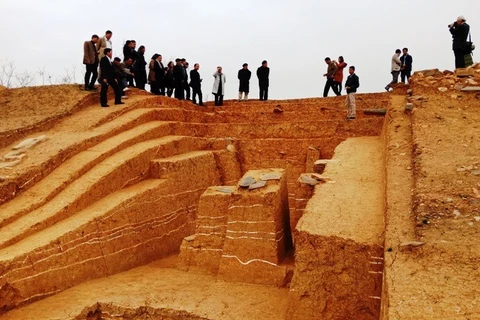Thanh Hoa (VNA) – An exhibition featuring Thanh Hoa cultural heritage is underway in the northern province of Thanh Hoa, as part of activities held to celebrate the 50th anniversary of the United Nations Educational, Scientific and Cultural Organisation (UNESCO)’s Convention Concerning the Protection of the World Cultural and Natural Heritage.
In particular, the exhibition introduces many precious images and documents about the Citadel of the Ho Dynasty, which was recognised as a World Cultural Heritage in 2011.
Thanh Hoa is home to many cultural heritage sites, including the Lam Kinh Special Relic Site, Con Moong Cave, Ba Trieu Temple and Le Hoan Temple Historic Sites, Ben En National Park, and games and performances which have been recognised as national intangible cultural heritage such as Chieng game and Cau Ngu festival.
A number of world heritage sites in other provinces and cities are also showcased at the exhibition namely Ha Long Bay, Phong Nha-Ke Bang National Park, Trang An Scenic Landscape Complex, Thang Long Imperial Citadel, Hoi An Ancient Town and My Son Sanctuary.
The Citadel of the Ho Dynasty was built in 1397 as the capital of Dai Ngu (the name of Vietnam at that time). It is unique for its outstanding construction technique which used large blocks of stone, weighing from 10 tonnes to 26 tonnes each, carefully shaped, interlocked and elevated to an altitude of about 10 meters.
The Ho Dynasty Citadel served as a military stronghold to protect the country from invasion, thus becoming a symbol of patriotism and national pride, and a witness of Vietnamese history during the late 14th and early 15th century. For the past six centuries, however, the forces of nature took its toll on the site.
After the citadel was recognised by UNESCO as a World Cultural Heritage in 2011, Thanh Hoa has paid attention and poured resources into archaeological excavations and heritage conservation, helping raise the community's awareness and responsibilities in preserving and promoting the heritage’s values.
The exhibition will last until the end of February next year.
The organisation of the event aims to popularise the potential and strengths of Thanh Hoa province's cultural heritage and tourism to domestic and foreign tourists. This is also a chance to promote cooperation and exchange of experiences in the management and conservation of cultural values among heritage sites in Vietnam./.
























